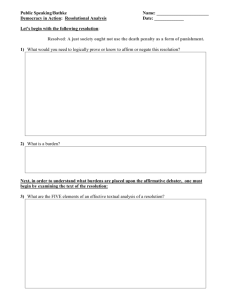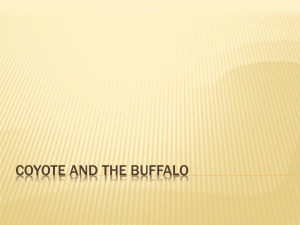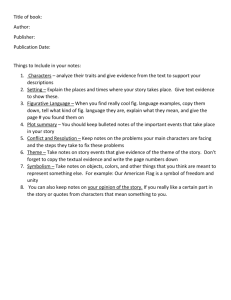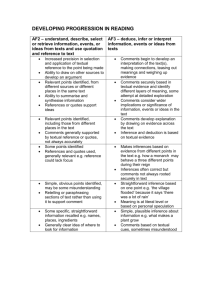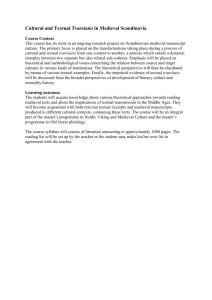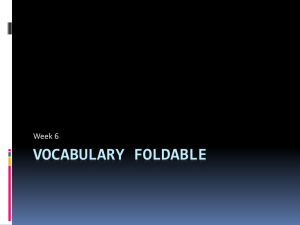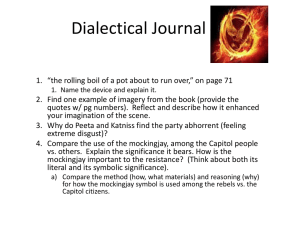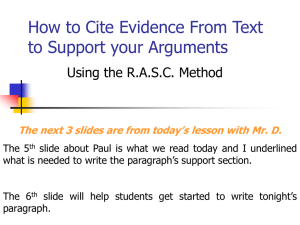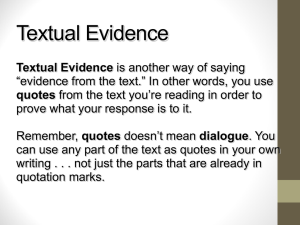Classification Using Various Machine Learning Methods and
advertisement
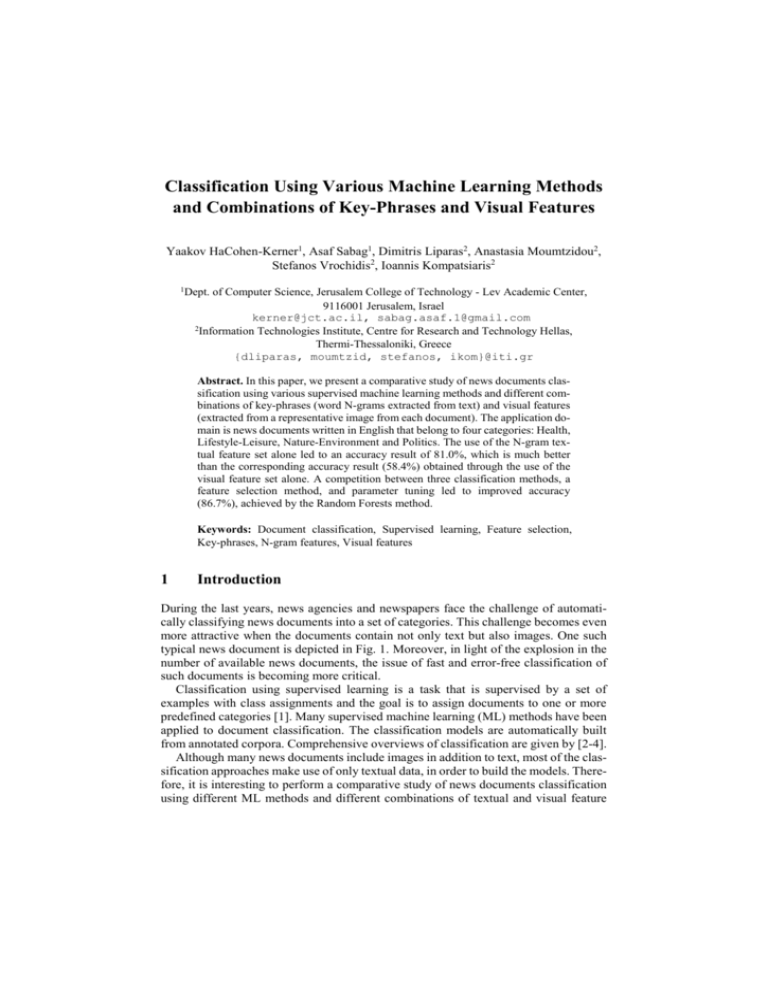
Classification Using Various Machine Learning Methods
and Combinations of Key-Phrases and Visual Features
Yaakov HaCohen-Kerner1, Asaf Sabag1, Dimitris Liparas2, Anastasia Moumtzidou2,
Stefanos Vrochidis2, Ioannis Kompatsiaris2
1Dept.
of Computer Science, Jerusalem College of Technology - Lev Academic Center,
9116001 Jerusalem, Israel
kerner@jct.ac.il, sabag.asaf.1@gmail.com
2Information Technologies Institute, Centre for Research and Technology Hellas,
Thermi-Thessaloniki, Greece
{dliparas, moumtzid, stefanos, ikom}@iti.gr
Abstract. In this paper, we present a comparative study of news documents classification using various supervised machine learning methods and different combinations of key-phrases (word N-grams extracted from text) and visual features
(extracted from a representative image from each document). The application domain is news documents written in English that belong to four categories: Health,
Lifestyle-Leisure, Nature-Environment and Politics. The use of the N-gram textual feature set alone led to an accuracy result of 81.0%, which is much better
than the corresponding accuracy result (58.4%) obtained through the use of the
visual feature set alone. A competition between three classification methods, a
feature selection method, and parameter tuning led to improved accuracy
(86.7%), achieved by the Random Forests method.
Keywords: Document classification, Supervised learning, Feature selection,
Key-phrases, N-gram features, Visual features
1
Introduction
During the last years, news agencies and newspapers face the challenge of automatically classifying news documents into a set of categories. This challenge becomes even
more attractive when the documents contain not only text but also images. One such
typical news document is depicted in Fig. 1. Moreover, in light of the explosion in the
number of available news documents, the issue of fast and error-free classification of
such documents is becoming more critical.
Classification using supervised learning is a task that is supervised by a set of
examples with class assignments and the goal is to assign documents to one or more
predefined categories [1]. Many supervised machine learning (ML) methods have been
applied to document classification. The classification models are automatically built
from annotated corpora. Comprehensive overviews of classification are given by [2-4].
Although many news documents include images in addition to text, most of the classification approaches make use of only textual data, in order to build the models. Therefore, it is interesting to perform a comparative study of news documents classification
using different ML methods and different combinations of textual and visual feature
sets, in order to see whether the addition of the visual features can improve the classification performance.
Fig. 1. Web-based news document from The Guardian entitled: The man in the digital mask1
In this paper, we explore domain-based classification of news documents using three
general types of features: textual N-gram features, visual features and a combination of
the above. The classification experiments are performed using three different supervised ML methods, namely J48, Random Forests (RF) and Sequential Minimal
Optimization (SMO).
The rest of the paper is structured as follows: Section 2 provides the relevant background concerning document classification. Section 3 describes the textual and visual
feature extraction procedures. Section 4 presents the involved classification methods,
the experimental results and their analysis. Finally, Section 5 summarizes the main
findings, concludes and suggests future directions.
2
Document Classification
Current-day document classification presents challenges due to the large number of
training documents, the large number of available features and their dependencies. The
document classification task is one of the most fundamental tasks in data mining and
ML literature [5]. Document classification has been successfully applied to many fields
such as document filtering, information extraction and text mining [6-8].
Document classification can be divided into two main types: according to categories
(e.g., fields and topics) and according to stylistic classification. Document classification
according to categories is usually based on content word or character N-grams. Some
examples of document classification according to categories are the following:
detection of author profiles for authorship attribution [8], detection of virus programs
[9] and phrase and topic discovery [10].
In contrast, stylistic classification utilizes various linguistic features, e.g., function
words, orthographic features, parts of speech (PoS) features, topographic features and
1
http://www.theguardian.com/technology/2015/sep/10/the-man-in-the-digital-mask-bill-shannon
vocabulary richness features. Examples of document classification according to
stylistic classification are: blog classification [11], computer science conference
classification [12], ethnicity/time/place classification [13-14], and sentiment
classification [15].
The majority of document classification-related studies consider only textual
features. For instance, [16] focus on political news by tracking blogs and the articles
they cite, tagging each article with the number of blogs citing it. They use a maximum
entropy classifier based on unigram features. [17] develop various criteria to predict the
popularity of news on Twitter and indicate that traditionally prominent news sources
differ from news sources that are popular in social media platforms. Moreover, [18]
present an approach for identifying and classifying contents of interest related to
geographic communities from news articles streams. Their approach contains two
stages: (1) Filtering out contents irrelevant to communities, and (2) Classifying the
remaining relevant news articles by means of a Bayesian text classifier. Finally, [19]
present learning of sentiment-specific word embedding for twitter sentiment
classification. They learn embedding for unigrams, bigrams and trigrams separately
using three developed neural networks.
Some examples of document classification studies that use only visual features are
the following: [20] classify document pages using various visual features that express
“visual similarity” of layout structure, e.g. percentages of text and non-text (graphics,
images, tables, and rulings) content regions, column structures, relative point sizes of
fonts, density of content area and statistics of features from connected components.
They implement their classification scheme using decision tree classifiers and self-organizing maps. [21] explore image clustering as a basis for constructing visual words
for representing documents. They apply the bag-of-words representation and standard
classification methods to train an image-based classifier. Their main contribution is the
exploration of a new space of features, based purely on the clustering of subfigures for
document classification.
The task of classifying documents that contain both textual and visual features is a
relatively new and interesting challenge. In this context, [22] explore the classification
of news articles using both textual and visual features. By using only N-gram textual
features they achieve a much better accuracy result than using only visual features. The
use of both N-gram textual features and visual features leads to slightly improved accuracy results. Furthermore, [23] classify document images by combining 1000 textual
features extracted with the Bag of Words (BoW) technique and 1000 visual features
extracted with the Bag of Visual Words (BoVW) technique. Experiments conducted on
an industrial document image database reveal that the proposed late fusion scheme significantly improves the classification performance.
3
Feature Extraction from News Documents
In this study, we assume that each news document has two main components: (a) the
textual information, and (b) the image(s). Firstly, we extract continuous word N-grams
(excluding stopwords) from the textual description of the given document. Secondly,
we extract low-level visual features from the biggest image of the document, which is
assumed to be the representative one.
3.1
Extraction of Key-Phrases
For the extraction of the textual features from a corpus of news web documents, the
following procedure is applied:
1. All appearances of 421stopwords for general texts in English are deleted [24].
2. All possible continuous N-gram words (N = 1, 2, 3, 4) from the examined
corpus are created, provided that the all the words in a certain N-gram are in
the same sentence.
3. The frequency of each N-gram feature in the corpus is counted.
4. The frequencies of the unigram, bigram, trigram and fourgram (each group
alone) features are sorted in descending order.
5. To avoid unnecessarily large number of N-grams, only a subset of the most
frequent features from each group is selected. More specifically, in our study,
624 of the most frequent N-gram features are selected as follows: a) 500 most
frequent unigrams; b) 100 most frequent bigrams; c) 20 most frequent trigrams and d) 4 most frequent fourgrams. The motivation for these numbers
is as follows: The larger the value of N is, the smaller the number of relatively
frequent N-grams in the corpus is. According to the abovementioned frequencies of the N-grams, the reduction factor was determined to be 5.
3.2
Extraction of Visual Features
The low-level visual feature that was used for capturing the characteristics of images is
the RGB-SIFT visual descriptor [25], which is an extension of SIFT. In general, SIFT
descriptors belong to the category of local descriptors that represent local salient points
and thus capture the characteristics of the interest points (or keypoint) of images. For
each keypoint only the pixel intensity of it is considered, while the color information is
dropped. On the other hand, RGB-SIFT considers not only the pixel intensity, but also
the color itself in the three channels Red, Green, Blue for each interest point. Thus, it
captures more information and is able to better represent the image, compared to SIFT.
However, when local descriptors are employed and given that the whole procedure is
arduous, a visual word assignment step is applied after the feature extraction step. Specifically, k-means clustering is applied to the produced features vectors, in order to
acquire the visual vocabulary. Finally, VLAD encoding is realized for representing images [26]. As a result, a descriptor is produced that gives an overall impression of the
visual data. In this case, the dimensionality of the visual feature set is 4000.
4
Application of ML Methods for Classification of News
Documents
Three supervised ML methods have been selected for the experiments in this study:
J48, Random Forests (RF) and Sequential Minimal Optimization (SMO). Below, a
short description of the methods is provided.
J48 is an improved variant of the C4.5 decision tree ML method [27], which is
implemented in the WEKA ML platform [28]. J48 generates pruned or unpruned C4.5
decision trees. At each step, the most predictive attribute is determined and a node is
split based on this attribute. J48 attempts to account for noise and missing data. It also
deals with numeric attributes by determining where thresholds for decision splits should
be placed.
Random Forests (RF) is an ensemble learning method for classification and
regression [29]. The basic concept of RF is the construction of a set of decision trees.
Moreover, two sources of randomness are employed in the operational procedures of
RF: (1) Each decision tree is grown on a different bootstrap sample drawn randomly
from the training data. (2) At each node split during the construction of a decision tree,
a random subset of m variables is selected from the original variable set and the best
split based on these m variables is used.
Sequential Minimal Optimization (SMO) [30-31] is an algorithm for solving the
optimization problem that occurs during the training of Support Vector Machines
(SVM) [32]. SMO divides this problem into a series of smallest possible sub-problems,
which are then resolved analytically.
5
Examined Corpus, Experimental Setup and Results
5.1
Examined corpus
The application domain is news documents written in English that belong to four categories: Health, Lifestyle-Leisure, Nature-Environment and Politics. The news documents were downloaded from a large number of news web-sites (http://www.washingtonpost.com/, http://www.huffingtonpost.com/, etc.) and were annotated manually. The
1237 documents of the corpus contain around one million words and around 6.2 million
characters. Table 1 presents some general information about the dataset and its domains
including number of documents, number of words, number of characters, average number of words per document and average number of characters per document.
Table 1. General information about the dataset
Domain
Health
LifestyleLeisure
NatureEnvironment
Politics
Total
5.2
# of
documents
# of
words
# of
characters
Avg. # of
words per
document
187
130,157
795,435
696
Avg. # of
characters
per document
4253.7
326
297,492
1,712,799
912.6
5254
447
250,859
1,543,137
561.2
3452.2
277
1237
352,177
1,030,685
2,145,257
6,196,628
1271.4
833.2
7744.6
5009.4
Experimental Setup
The three supervised ML methods were applied using the WEKA platform, along with
their default parameter values, which are described below:
J48: minNumObj = 2 (the minimum number of instances per leaf), confidenceFactor
= 0.25 (the confidence factor used for pruning) and seed = 1 (the value used for
randomizing the data when reduced-error pruning is used).
RF: numTrees = 100 (the number of trees to be generated), maxDepth = 0 (unlimited
maximum depth of the trees) and seed =1 (the random number seed to be used).
SMO: The kernel to use is the polynomial kernel (exponent = 1.0 and cachSize =
250007), c = 1.0 (the complexity parameter), toleranceParameter = 0.001 and
randomSeed = 1 (the random number seed for the cross-validation).
It should be noted that for all classification experiments, a 10-fold cross-validation
scheme was adopted. The measures used for evaluating the performance of the methods
are the following: accuracy (test set), precision, recall and F-score for each category.
After determining the two ML methods that gave the best results, we performed additional experiments using only these methods. Non-relevant features were filtered out
by means of a filter method for feature selection in WEKA called CfsSubsetEval (Correlation-based Feature Subset Selection) [33]. CfsSubsetEval evaluates a subset of features by considering the individual predictive ability of each feature along with the degree of redundancy between them. Subsets of features that are highly correlated with
the class, while having low inter-correlation are preferred. All the optimized parameter
values were obtained as follows: each parameter was tuned in a hill climbing fashion,
changing one parameter at a time (manually) until the best value was obtained.
5.3
Results
Table 2 presents the accuracy results (%) for various combinations of feature sets
using 3 ML methods (J48, RF and SMO) with their default parameter values. We relate
to the accuracy that were achieved by all 624 N-gram features (81.0%) using the RF
method with default parameter values (the number of trees was set to 100) as the baseline, with which to compare the other results. The performance of the N-gram feature
set is superior to that of the visual feature set (58.4%) not only in this study, but in a
previous related study as well [22].
Table 2. Accuracy results (%) for various combinations of feature sets using 3 ML methods
Combinations of features
624 textual features
4000 visual features
59 textual features (Best First – 565 were
filtered)
31 visual features (Best First – 3969 were
filtered)
624 textual & 4000 visual features
59 textual & 4000 visual features
624 textual & 31 visual features
59 textual & 31 visual features
J48
69.6
55.1
72.9
RF
81.0
58.4
82.3
SMO
80.8
57.3
79.8
54.2
59.4
52.1
69.7
69.5
68.4
72.7
68.5
68.5
85.2
85.9
81.2
80.8
83.9
82.9
Some general conclusions that can be drawn from Table 2 are the following:
The results presented in the first two rows of the table show that the basic textual
feature set is superior to the corresponding visual feature set for all three ML methods. A possible explanation for this is the following: the textual features describe
widespread information about the whole text, while the visual features describe
information about only one representative image.
The best accuracy result (85.9%) is achieved by RF using two reduced feature sets:
59 textual features and 31 visual features. On the other hand, SMO achieves only
82.9% for the same combination of features. Finally, the J48 method obtains the
worst accuracy results for almost all the conducted experiments.
There are two interesting opposing phenomena: SMO beats RF when using 4000
visual features and any set of textual features, while RF is better than SMO for all
the other experiments. A possible explanation for this could be the fact that SVM
(SMO in our case) is known to perform well in high-dimensional feature spaces
[34].
The improvement rate from the best unique set (59 textual features – 82.3%) to the
best combination of feature sets (59 textual features & 31 visual features – 85.9%)
is 3.6%.
As previously mentioned, we decided to perform further experiments using only the
two best ML methods according to Table 2: RF and SMO. Tables 3 and 4 provide the
optimized accuracy results for all combinations of feature sets using RF and SMO, respectively. In both Tables we also present the precision, recall and F-score results for
each category and for all feature set combinations presented in Table 2.
The optimized results in Table 3 for the RF model have been achieved with 800 trees
(experiments were conducted for various numbers of trees between 100 and 1200) and
seed = 3. On the other hand, the optimized results in Table 4 for the SMO model have
been achieved with Normalized Polynomial Kernel, toleranceParameter = 0.003, c = 9
and randomSeed = 1. For both ML methods, parameters that are not mentioned here are
kept with their default values. Any change in their values did not improve the
classification performance results.
Table 3. Classification results (%) for different combinations of feature sets (RF with
the best parameter values)
Health
LifestyleLeisure
NatureEnvironment
Politics
Combinations of
features
Acc
624 textual
83.1
93.3 59.4 72.5 79.2 92.0 85.1 81.3 91.7 86.2 88.1 74.7 80.8
4000 visual
58.3
61.1 57.2 59.1 53.6 66.9 59.5 58.3 63.5 60.8 66.7 40.4 50.3
59 textual
82.5
83.1 71.1 76.7 79.4 85.0 82.1 83.1 88.8 85.8 85.2 76.9 80.8
31 visual
59.7
59.8 57.2 58.5 57.1 67.8 62.0 59.2 66.0 62.4 30.2 66.5 41.5
624 textual &
4000 visual
67.8
77.4 56.7 65.4 60.2 77.0 67.6 68.5 75.8 72.0 76.1 51.6 61.5
59 textual &
4000 visual
69.0
83.2 61.0 70.4 58.4 81.3 67.9 72.5 75.4 73.9 76.2 49.8 60.2
624 textual &
31 visual
84.9
87.7 65.1 74.7 82.0 91.1 86.3 83.2 93.1 87.9 91.1 77.6 83.8
59 textual &
31 visual
86.7
89.2 75.4 81.7 85.7 90.2 87.9 85.8 91.7 88.6 88.0 81.9 84.8
Pre Rec
FFFFPre Rec
Pre Rec
Pre Rec
sco
sco
sco
sco
Below we provide some general conclusions that can be drawn from Table 3:
The best combination of features (59 textual features and 31 visual features) achieves
an accuracy value of 86.7% and F-score values between 81.7% and 88.6% for the
four categories.
The precision values for the textual feature sets (624 and 59 textual features) are
significantly higher than the corresponding recall values for the categories “Health”
and “Politics”. Higher precision values indicate less false positives, which means that
the RF method with the use of the textual features has a high ability to present relevant
“Health” and “Politics” documents. Similar observations can be made for the feature
combinations that include both textual and visual features, probably due to the
decisive impact of the textual features.
On the other hand, the recall values are significantly higher than the corresponding
precision values for the categories “Lifestyle-Leisure” and “Nature-Environment”.
Higher recall values indicate less false negatives. This means that the RF method has
a high ability to classify “Lifestyle-Leisure” and “Nature-Environment” documents
accurately.
The worst results for all types of feature combinations are obtained for the categories
“Health” and “Politics”. A possible explanation is that these categories contain a
widespread variety of topics and therefore, their features vary strongly.
Table 4. Classification results (%) for different combinations of feature sets (SMO
with the best parameter values)
LifestyleLeisure
Health
NatureEnvironment
Politics
Combinations of
features
Acc
624 textual
82.3 89.9 66.8 76.6 79.0 86.5 82.6 81.1 90.2 85.4 85.2 75.1 79.8
4000 visual
57.9 59.2 55.1 57.1 55.5 65.3 60.0 57.9 61.3 59.6 61.2 45.5 52.2
59 textual
76.6 72.8 71.7 72.2 71.0 75.8 73.3 80.5 79.4 80.0 79.9 76.2 78.0
31 visual
55.8 52.2 50.3 51.2 52.2 58.6 55.2 57.9 65.1 61.3 60.6 41.2 49.0
Pre Rec
F-s
Pre Rec
F-s
Pre Rec
F-s
Pre Rec
F-s
624 textual &
71.2 72.4 60.4 65.9 68.9 77.6 73.0 70.9 78.5 74.5 74.9 59.2 66.1
4000 visual
59 textual &
4000 visual
54.7 51.9 42.8 46.9 50.8 65.0 57.0 54.6 64.0 58.9 69.7 35.7 47.2
624 textual &
85.2 87.9 78.0 82.6 85.3 87.1 86.2 83.5 88.4 85.9 86.4 82.7 84.5
31 visual
59 textual &
31 visual
83.9 86.5 75.4 80.6 81.4 88.7 84.9 86.3 85.7 86.0 81.8 81.2 81.5
Below we provide some general conclusions that can be drawn from Table 4:
In contrast to the best RF combination of features (59 textual features and 31 visual
features), the best feature combination for SMO uses 31 visual and all 624 textual
features. This combination achieves an accuracy value of 85.2% and F-score values
between 82.6% and 86.2% for the four categories.
Similar to the RF results, the SMO precision values regarding the best unique textual
feature set (624 textual) are significantly higher than the corresponding recall values
for the categories “Health” and “Politics”. On the other hand, for the majority of the
feature sets, the recall values are significantly higher than the corresponding precision
values for the categories “Lifestyle-Leisure” and “Nature-Environment”. Finally, just
like in the case of the RF model, the SMO worst results are obtained for the “Health”
and “Politics” categories for almost all types of feature combinations.
6
Summary, Conclusions and Future Work
In this study, we present a comparative classification study of news documents using
three popular ML methods (J48, RF, and SMO), and different combinations of keyphrases (word n-grams excluding stopwords) and visual features. This comparative
study is in contrast to two previous studies [22-23] that also perform classification with
both textual and visual features but using only one ML method, one combination of
textual and visual features and no feature selection.
Using the N-gram textual feature set containing 624 features led to an accuracy result
of 81.0%. This result was much better than the accuracy result (58.4%) obtained for the
visual feature set containing 4000 low-level features. A possible explanation for this
finding is that the textual features describe widespread information about the whole
text, while the visual features describe information about only one representative image. The use of the best combination of feature sets (59 textual features and 31 visual
features) and the best parameter values for the RF model (800 trees) resulted in an accuracy result of 86.7%. Regarding SMO, the use of the best combination of feature sets
(624 textual features and 31 visual features) and the best parameter values led to a small
accuracy improvement of 1.3% (from 83.9% to 85.2%).
Suggestions for future research are: (1) Define and implement additional types of
features, such as function words, morphological features (e.g. nouns, verbs and adjectives), quantitative features (e.g. average number of letters per word, average number
of words per sentence) and web-oriented features, (2) Define and implement high-level
visual concepts, in order to employ them in the classification tasks and (3) Apply additional ML methods to larger datasets in the news documents area, as well as in other
areas, using various combinations of textual and visual features.
Acknowledgments. This work was supported by MULTISENSOR project, partially
funded by the European Commission, under the contract number FP7-610411. The authors would also like to thank Avi Rosenfeld, Maor Tzidkani and Daniel Nissim Cohen
from the Jerusalem College of Technology, Lev Academic Center, for their assistance
to the authors in providing the software tool to generate the textual features used in this
research. The authors would also like to acknowledge the networking support by the
COST Action IC1302: semantic KEYword-based Search on sTructured data sOurcEs
(KEYSTONE) and the COST Action IC1307: The European Network on Integrating
Vision and Language (iV&L Net).
References
1. Sebastiani, F.: Machine Learning in Automated Text Categorization. ACM Computing Surveys, 34 (1), pp. 1-47 (2002)
2. Ozgür, A.: Supervised and Unsupervised Machine Learning Techniques for Text Document
Categorization (Doctoral dissertation, Bogaziçi University) (2004)
3. Kotsiantis, S. B., Zaharakis, I., Pintelas, P.: Supervised Machine learning: A Review of Classification Techniques, Informatica 31, 249-268 (2007)
4. Aggarwal, C. C., Zhai, C.: Mining Text Data. Springer Science & Business Media (2012)
5. Pazienza, M. T. (Ed.): Information Extraction: A Multidisciplinary Approach to an Emerging Information Technology (Vol. 1299), Springer (1997)
6. Sebastiani, F.: Text Categorization. In: Zanasi, Alessandro (Ed.), Text Mining and its Applications to Intelligence. CRM and Knowledge Management, WIT Press, Southampton,
UK, pp. 109–129 (2005)
7. Kim, S. M., Hovy, E.: Automatic Identification of Pro and Con Reasons in Online Reviews.
In Proceedings of the COLING/ACL on main conference poster sessions, pp. 483-490, Association for Computational Linguistics (2006)
8. Kešelj, V., Peng, F., Cercone, N., Thomas, C.: N-gram-based author profiles for authorship
attribution. In Proceedings of the conference pacific association for computational linguistics, PACLING, Vol. 3, pp. 255-264 (2003)
9. Reddy, D. K. S., Pujari, A. K.: N-gram Analysis for Computer Virus Detection, Journal in
Computer Virology, 2(3), 231-239 (2006)
10. Wang, X., McCallum, A., Wei, X.: Topical N-grams: Phrase and Topic Discovery, with an
Application to Information Retrieval. Seventh IEEE International Conference on ICDM, pp.
697-702 (2007)
11. Ikeda, D., Takamura, H., Okumura, M.: Semi-Supervised Learning for Blog Classification, AAAI, pp. 1156-1161 (2008)
12. HaCohen-Kerner, Y., Rosenfeld, A., Tzidkani, M., Cohen, D. N.: Classifying Papers from
Different Computer Science Conferences. In Proceedings of the 9th International Conference on Advanced Data Mining and Applications (ADMA), China, Part I, LNAI 8346,
Springer, Heidelberg, pp. 529–541 (2013)
13. HaCohen-Kerner, Y., Beck, H., Yehudai, E., Mughaz, D.: Stylistic Feature Sets as Classifiers of Documents According to their Historical Period and Ethnic Origin. Applied Artificial
Intelligence, 24(9), pp. 847-862 (2010)
14. HaCohen-Kerner, Y., Beck, H., Yehudai, E., Rosenstein, M., Mughaz, D.: Cuisine: Classification using Stylistic Feature Sets and/or Name-based Feature Sets. Journal of the American Society for Information Science and Technology, 61(8), pp. 1644-1657 (2010)
15. Kennedy, A., Inkpen, D.: Sentiment Classification of Movie Reviews using Contextual Valence Shifters. Computational intelligence, 22(2), 110-125 (2006)
16. Gamon, M., Basu, S., Belenko, D., Fisher, D., Hurst, M., König, A. C.: BLEWS: Using
Blogs to Provide Context for News Articles. In: Proceedings of the second international
AAAI conference on weblogs and social media (ICWSM), Seattle, Washington, March 30
– April 2 (2008)
17. Bandari, R., Asur, S., Huberman, B. A.: The Pulse of News in Social Media: Forecasting
Popularity. In Proceedings of the In: Proceedings of the sixth international AAAI conference on weblogs and social media (ICWSM) (Arxiv preprint arXiv), Dublin 4–7 June, vol.
1202, pp. 26–33 (2012)
18. Swezey, R. M. E., Sano, H., Shiramatsu, S., Ozono, T., Shintani, T.: Automatic Detection
of News Articles of Interest to Regional Communities. International Journal of Computer
Science and Network Security (IJCSNS), 12(6), pp. 99-106 (2012)
19. Tang, D., Wei, F., Yang, N., Zhou, M., Liu, T., Qin, B.: Learning Sentiment-specific Word
Embedding for Twitter Sentiment Classification. In Proceedings of the 52 nd Annual Meeting
of the Association for Computational Linguistics, Vol. 1, pp. 1555-1565 (2014)
20. Shin, C., Doermann, D., Rosenfeld, A.: Classification of document pages using structurebased features. International Journal on Document Analysis and Recognition, 3(4), pp. 232247 (2001)
21. Chen, N., Shatkay, H., Blostein, D.: Exploring a new space of features for document classification: figure clustering. In Proceedings of the 2006 conference of the Center for Advanced
Studies on Collaborative research, pp. 35, IBM Corp (2006)
22. Liparas, D., HaCohen-Kerner, Y., Moumtzidou, A., Vrochidis, S., Kompatsiaris, I.: News
Articles Classification Using Random Forests and Weighted Multimodal Features. In Proceedings of the 3rd Open Interdisciplinary MUMIA Conference and 7th Information Retrieval Facility Conference (IRFC2014), LNCS 8849, pp. 63-75, Berlin: Springer-Verlag
(2014)
23. Augereau, O., Journet, N., Vialard, A., Domenger, J. P.: Improving Classification of an Industrial Document Image Database by Combining Visual and Textual Features. In Document Analysis Systems (DAS), In Proceedings of the11th International Workshop on IAPR,
pp. 314-318, IEEE (2014)
24. Fox, C.: A Stop List for General Text. ACM SIGIR Forum, 24 (1-2), pp. 19-35 (1989)
25. Van De Sande, K. E., Gevers, T., Snoek, C. G.: Evaluating Color Descriptors for Object and
Scene Recognition, Pattern Analysis and Machine Intelligence, IEEE Transactions on,
32(9), pp. 1582-1596 (2010)
26. Jégou, H., Douze, M., Schmid, C., Pérez, P.: Aggregating Local Descriptors into a Compact
Image Representation, In Proceedings of the IEEE Conference on Computer Vision & Pattern Recognition, pp. 3304-3311 (2010)
27. Quinlan, J. R.: C4.5: Programs for Machine Learning. San Mateo: Morgan Kaufmann (1993)
28. Hall, M., Frank, E., Holmes, G., Pfahringer, B., Reutemann, P., Witten, I. H.: The WEKA
Data Mining Software: an Update. ACM SIGKDD Explorations Newsletter, 11(1), pp. 10–
18 (2009)
29. Breiman, L.: Random Forests. Machine Learning, 45(1), pp. 5-32 (2001)
30. Platt J.: Fast Training of Support Vector Machines using Sequential Minimal Optimization.
In Schoelkopf, B., Burges, C. Smola, A. (eds.), Advances in Kernel Methods – Support
Vector Learning. Cambridge MA: MIT Press, pp. 185-208 (1998)
31. Keerthi, S. S., Shevade, S. K., Bhattacharyya, C., Murthy, K. R. K.: Improvements to Platt's
SMO Algorithm for SVM Classifier Design. Neural Computation, 13 (3), pp. 637-649
(2001)
32. Cortes, C., Vapnik, V.: Support-Vector Networks. Machine Learning, 20, pp. 273-297
(1995)
33. Hall, M. A.: Correlation-based Feature Subset Selection for Machine Learning. Hamilton,
New Zealand (1998)
34. Forman, G.: An Extensive Empirical Study of Feature Selection Metrics for Text Classification. J. of Machine Learning Research, 3:1289–1305 (2003)

